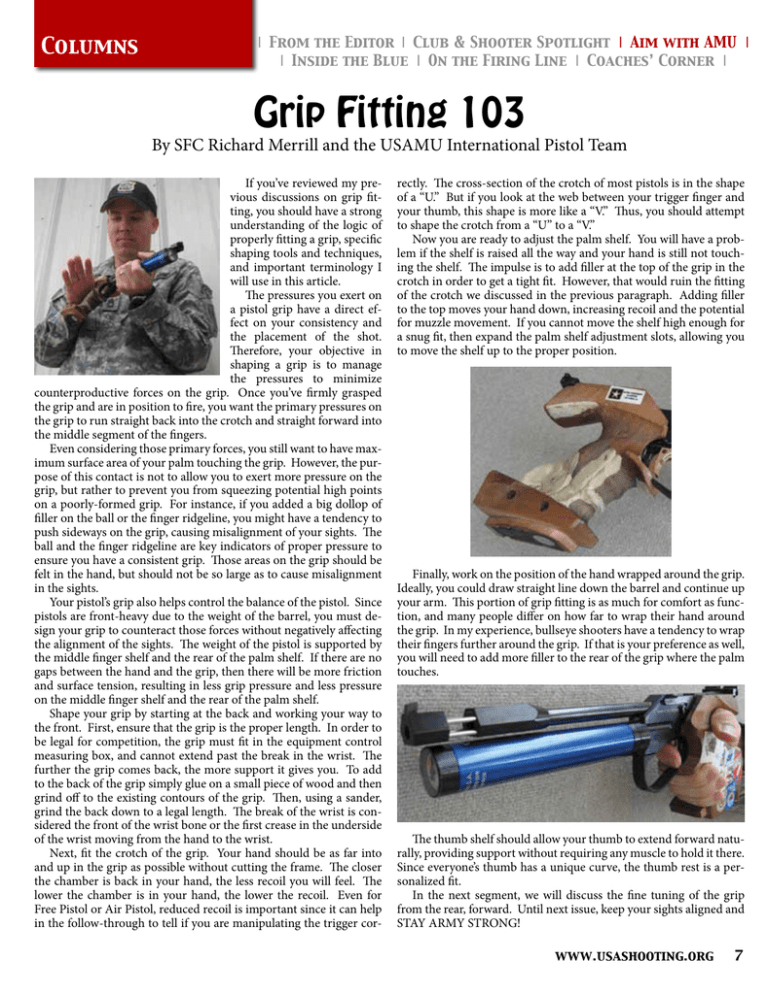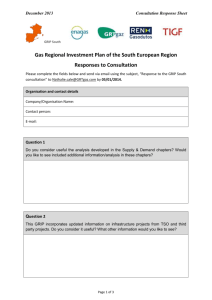Grip Fitting 103
advertisement

Columns x From the Editor x Club & Shooter Spotlight x Aim with AMU x x Inside the Blue x On the Firing Line x Coaches’ Corner x Grip Fitting 103 By SFC Richard Merrill and the USAMU International Pistol Team If you’ve reviewed my previous discussions on grip fitting, you should have a strong understanding of the logic of properly fitting a grip, specific shaping tools and techniques, and important terminology I will use in this article. The pressures you exert on a pistol grip have a direct effect on your consistency and the placement of the shot. Therefore, your objective in shaping a grip is to manage the pressures to minimize counterproductive forces on the grip. Once you’ve firmly grasped the grip and are in position to fire, you want the primary pressures on the grip to run straight back into the crotch and straight forward into the middle segment of the fingers. Even considering those primary forces, you still want to have maximum surface area of your palm touching the grip. However, the purpose of this contact is not to allow you to exert more pressure on the grip, but rather to prevent you from squeezing potential high points on a poorly-formed grip. For instance, if you added a big dollop of filler on the ball or the finger ridgeline, you might have a tendency to push sideways on the grip, causing misalignment of your sights. The ball and the finger ridgeline are key indicators of proper pressure to ensure you have a consistent grip. Those areas on the grip should be felt in the hand, but should not be so large as to cause misalignment in the sights. Your pistol’s grip also helps control the balance of the pistol. Since pistols are front-heavy due to the weight of the barrel, you must design your grip to counteract those forces without negatively affecting the alignment of the sights. The weight of the pistol is supported by the middle finger shelf and the rear of the palm shelf. If there are no gaps between the hand and the grip, then there will be more friction and surface tension, resulting in less grip pressure and less pressure on the middle finger shelf and the rear of the palm shelf. Shape your grip by starting at the back and working your way to the front. First, ensure that the grip is the proper length. In order to be legal for competition, the grip must fit in the equipment control measuring box, and cannot extend past the break in the wrist. The further the grip comes back, the more support it gives you. To add to the back of the grip simply glue on a small piece of wood and then grind off to the existing contours of the grip. Then, using a sander, grind the back down to a legal length. The break of the wrist is considered the front of the wrist bone or the first crease in the underside of the wrist moving from the hand to the wrist. Next, fit the crotch of the grip. Your hand should be as far into and up in the grip as possible without cutting the frame. The closer the chamber is back in your hand, the less recoil you will feel. The lower the chamber is in your hand, the lower the recoil. Even for Free Pistol or Air Pistol, reduced recoil is important since it can help in the follow-through to tell if you are manipulating the trigger cor- rectly. The cross-section of the crotch of most pistols is in the shape of a “U.” But if you look at the web between your trigger finger and your thumb, this shape is more like a “V.” Thus, you should attempt to shape the crotch from a “U” to a “V.” Now you are ready to adjust the palm shelf. You will have a problem if the shelf is raised all the way and your hand is still not touching the shelf. The impulse is to add filler at the top of the grip in the crotch in order to get a tight fit. However, that would ruin the fitting of the crotch we discussed in the previous paragraph. Adding filler to the top moves your hand down, increasing recoil and the potential for muzzle movement. If you cannot move the shelf high enough for a snug fit, then expand the palm shelf adjustment slots, allowing you to move the shelf up to the proper position. Finally, work on the position of the hand wrapped around the grip. Ideally, you could draw straight line down the barrel and continue up your arm. This portion of grip fitting is as much for comfort as function, and many people differ on how far to wrap their hand around the grip. In my experience, bullseye shooters have a tendency to wrap their fingers further around the grip. If that is your preference as well, you will need to add more filler to the rear of the grip where the palm touches. The thumb shelf should allow your thumb to extend forward naturally, providing support without requiring any muscle to hold it there. Since everyone’s thumb has a unique curve, the thumb rest is a personalized fit. In the next segment, we will discuss the fine tuning of the grip from the rear, forward. Until next issue, keep your sights aligned and STAY ARMY STRONG! www.usashooting.org 7

